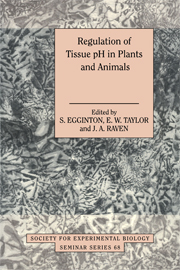Book contents
- Frontmatter
- Contents
- List of contributors
- Preface
- Measurement of intracellular pH: a comparison between ion-sensitive microelectrodes and fluorescent dyes
- pH-sensitive microelectrodes: how to use them in plant cells
- The use of nuclear magnetic resonance for examining pH in living systems
- Invasive studies of intracellular acid–base parameters: quantitative analyses during environmental and functional stress
- Lactate, H+ and ammonia transport and distribution in rainbow trout white muscle after exhaustive exercise
- Limiting factors for acid–base regulation in fish: branchial transfer capacity versus diffusive loss of acid–base relevant ions
- H+-mediated control of ion channels in guard cells of higher plants
- pH regulation of plants with CO2-concentrating mechanisms
- Intracellular pH regulation in plants under anoxia
- The role of turtle shell in acid–base buffering
- Acid–base regulation in crustaceans: the role of bicarbonate ions
- A novel role for the gut of seawater teleosts in acid–base balance
- pH and smooth muscle: regulation and functional effects
- Regulation of pH in vertebrate red blood cells
- Acid–base regulation in hibernation and aestivation
- Hepatic metabolism and pH in starvation and refeeding
- Back to basics: a plea for a fundamental reappraisal of the representation of acidity and basicity in biological solutions
- Index
The use of nuclear magnetic resonance for examining pH in living systems
Published online by Cambridge University Press: 22 August 2009
- Frontmatter
- Contents
- List of contributors
- Preface
- Measurement of intracellular pH: a comparison between ion-sensitive microelectrodes and fluorescent dyes
- pH-sensitive microelectrodes: how to use them in plant cells
- The use of nuclear magnetic resonance for examining pH in living systems
- Invasive studies of intracellular acid–base parameters: quantitative analyses during environmental and functional stress
- Lactate, H+ and ammonia transport and distribution in rainbow trout white muscle after exhaustive exercise
- Limiting factors for acid–base regulation in fish: branchial transfer capacity versus diffusive loss of acid–base relevant ions
- H+-mediated control of ion channels in guard cells of higher plants
- pH regulation of plants with CO2-concentrating mechanisms
- Intracellular pH regulation in plants under anoxia
- The role of turtle shell in acid–base buffering
- Acid–base regulation in crustaceans: the role of bicarbonate ions
- A novel role for the gut of seawater teleosts in acid–base balance
- pH and smooth muscle: regulation and functional effects
- Regulation of pH in vertebrate red blood cells
- Acid–base regulation in hibernation and aestivation
- Hepatic metabolism and pH in starvation and refeeding
- Back to basics: a plea for a fundamental reappraisal of the representation of acidity and basicity in biological solutions
- Index
Summary
Introduction
In what has become a classic paper, Moon and Richards (1973) demonstrated that phosphate compounds which occur naturally in cells could be used to measure intracellular pH (pHi) non-invasively using 31P nuclear magnetic resonance (NMR). The ability to probe a quantity as integral to cellular function as pH in living, unperturbed cells offered the promise of vast new insights into cellular metabolism. Indeed, hundreds of papers have been published as a direct result of Moon and Richards' original contribution, and the indirect impact of their work on the development of other applications of NMR to biology may be even greater. Today, NMR methods of pH measurement are common in clinical as well as in academic settings. In many cases, 31P-spectra are collected routinely as a means of assessing the energetic and acid–base status of a plant or animal sample during an experimental procedure. Many new NMR pH indicator compounds have been characterized, both endogenous and exogenous, which probe both pHi and extracellular pH (pHe). In addition, a wide variety of experimental protocols have been developed to examine acid–base balance non-invasively, including spectroscopy of isolated tissues and organs, in vivo localized spectroscopy, and imaging methods.
This brief review discusses the principles of pH measurement using NMR and highlights many of the pH indicator compounds that are currently employed. The strengths and weaknesses of NMR measurement of pH are discussed, as are sources of error. Finally, applications to comparative animal and plant physiology are described to provide practical examples of the kinds of experiments that are possible and information that can be obtained using this methodology.
- Type
- Chapter
- Information
- Regulation of Tissue pH in Plants and AnimalsA Reappraisal of Current Techniques, pp. 45 - 68Publisher: Cambridge University PressPrint publication year: 1999
- 2
- Cited by



